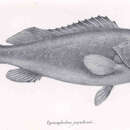Diagnostic Description
provided by Fishbase
Distinguished by the following characteristics: color is dark purplish gray with scattered irregular whitish spots and blotches which are faint or absent in preserved fish; ctenoid body scales except cycloid dorsoanteriorly below anterior half of spinous dorsal fin, thorax, abdomen and above anterior anal fin; body with numerous auxiliary scales; greatest depth of body 2.5-3.0 in SL; slightly emarginate to truncate caudal fin; short pelvic fins, 1.7-2.3 in head length (Ref. 90102); head length 2.4-2.7 times in SL; distinctly convex interorbital, slightly convex dorsal head profile; subangular preopercle, shallow notch just above the angle, serrae at angle not or slightly enlarged; upper edge of operculum straight; posterior nostrils of adults is twice the size of anterior nostrils; maxilla reaches vertical at rear edge of eye or thereabouts; ventral edge of maxilla of adults with distinct step distally; 2 rows of teeth on midlateral part of lower jaw (Ref. 89707).
Life Cycle
provided by Fishbase
Rock cod are protogynous hermaphrodites.
Morphology
provided by Fishbase
Dorsal spines (total): 11; Dorsal soft rays (total): 15 - 17; Analspines: 3; Analsoft rays: 8
Trophic Strategy
provided by Fishbase
Inhabit clear to turbid water in shallow as well as deep water (Ref. 4787). Juveniles are found in inshore coral reefs (Ref. 5222). They feed in water to more than 100 m depth (Ref. 27275). It has been suggested that juveniles mimic the herbivorous damselfish Neopomacentrus sindensis, presumably to get closer to their unsuspecting prey (Ref. 5222, 9710). Feed on small fishes and crabs. Probably spawn during restricted periods and form aggregations when doing so (Ref. 27352). Eggs and early larvae are probably pelagic (Ref. 6390). Rankin's rock cod feed in water to more than 100 m depth (Ref. 27275). Probably make frequent use of shelters, suggesting an 'ambush' method of feeding (Ref. 6390).
Biology
provided by Fishbase
Inhabit clear to turbid water in shallow as well as deep water (Ref. 4787). Juveniles are found in inshore coral reefs (Ref. 5222). They feed in water to more than 100 m depth (Ref. 27275). It has been suggested that juveniles mimic the herbivorous damselfish Neopomacentrus sindensis, presumably to get closer to their unsuspecting prey (Ref. 5222, 9710). Feed on small fishes and crabs. Probably spawn during restricted periods and form aggregations when doing so (Ref. 27352). Eggs and early larvae are probably pelagic (Ref. 6390). Solitary (Ref 90102).
- Recorder
- Estelita Emily Capuli
Importance
provided by Fishbase
fisheries: commercial
- Recorder
- Estelita Emily Capuli
Description
provided by World Register of Marine Species
Juveniles found in inshore coral reefs, and adults are more common in deeper water. Feeds on small fishes and crabs. It has been suggested that juveniles mimic the herbivorous damselfish @Neopomacentrus sindensis@, presumably to get closer to their unsuspecting prey.
Froese, R. & D. Pauly (Editors). (2023). FishBase. World Wide Web electronic publication. version (02/2023).
- license
- cc-by-4.0
- copyright
- WoRMS Editorial Board

